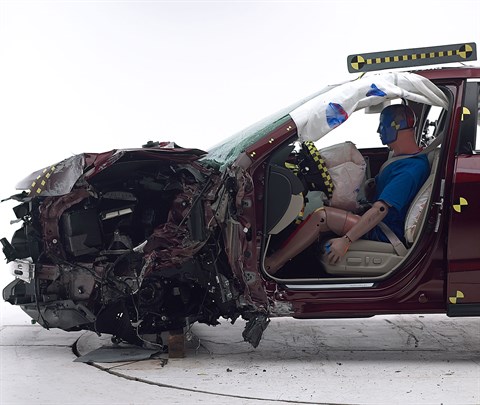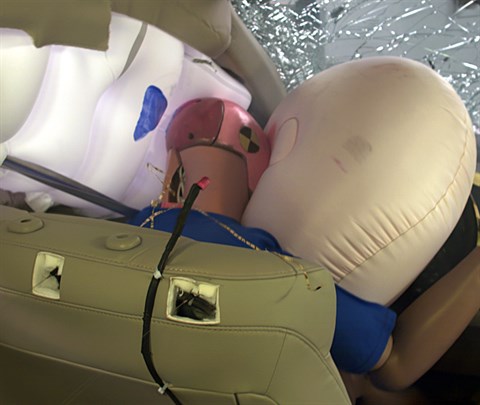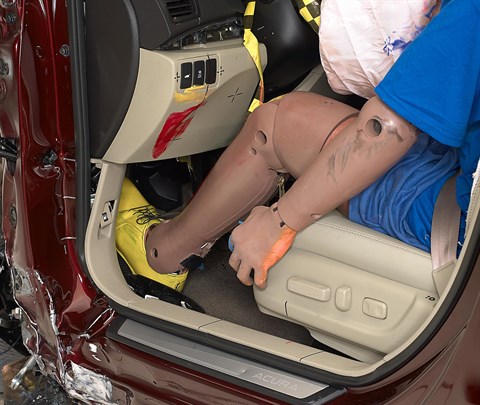Small overlap front: driver-side
Rating applies to 2016-18 models
Tested vehicle: 2016 Acura RDX 4-door 4wd
The Acura RDX was redesigned for the 2013 model year. Beginning with 2016 models, the RDX was re-engineered with front-end and occupant compartment structural modifications to improve occupant protection in both small overlap and moderate overlap frontal crashes.
| Evaluation criteria | Rating |
|---|---|
| Structure and safety cage | |
| Driver injury measures | |
| Head/neck | |
| Chest | |
| Hip/thigh | |
| Lower leg/foot | |
| Driver restraints and dummy kinematics | |

Action shot taken during the small overlap frontal crash test.

The dummy's position in relation to the door frame, steering wheel, and instrument panel after the crash test indicates that the driver's survival space was maintained well.

The frontal and side curtain airbags worked well together to keep the head from coming close to any stiff structure or outside objects that could cause injury.

The driver's space was maintained well, and risk of injuries to the dummy's legs and feet was low.
Measures of occupant compartment intrusion on driver side
| Evaluation criteria | Measurement |
|---|---|
| Test ID | CEN1529 |
| Lower occupant compartment | |
| Lower hinge pillar max (cm) | 5 |
| Footrest (cm) | 4 |
| Left toepan (cm) | 6 |
| Brake pedal (cm) | 8 |
| Parking brake (cm) | 13 |
| Rocker panel lateral average (cm) | 2 |
| Upper occupant compartment | |
| Steering column | 1 |
| Upper hinge pillar max (cm) | 4 |
| Upper dash (cm) | 1 |
| Lower instrument panel (cm) | 4 |
Driver injury measures
| Evaluation criteria | Measurement |
|---|---|
| Test ID | CEN1529 |
| Head | |
| HIC-15 | 202 |
| Peak gs at hard contact | no contact |
| Neck | |
| Tension (kN) | 2.0 |
| Extension bending moment (Nm) | 16 |
| Maximum Nij | 0.32 |
| Chest maximum compression (mm) | 19 |
| Femur (kN) | |
| Left | 1.6 |
| Right | 0.0 |
| Knee displacement (mm) | |
| Left | 1 |
| Right | 0 |
| Knee-thigh-hip injury risk (%) | |
| Left | 0 |
| Right | 0 |
| Maximum tibia index | |
| Left | 0.56 |
| Right | 0.66 |
| Tibia axial force (kN) | |
| Left | 1.4 |
| Right | 1.7 |
| Foot acceleration (g) | |
| Left | 52 |
| Right | 59 |
Moderate overlap front: original test
Rating applies to 2016-18 models
Tested vehicle: 2016 Acura RDX Technology 4-door 4wd
The Acura RDX was redesigned for the 2013 model year. Beginning with 2016 models, the RDX was re-engineered with front-end and occupant compartment structural modifications to improve occupant protection in both small overlap and moderate overlap frontal crashes.
Moderate overlap frontal ratings are assigned by the Institute based on a test conducted by Honda. (The car tested by Honda was designated as a 2013 model but included all modifications applied to the 2016 models.)
| Evaluation criteria | Rating |
|---|---|
| Overall evaluation | |
| Structure and safety cage | |
| Driver injury measures | |
| Head/neck | |
| Chest | |
| Leg/foot, left | |
| Leg/foot, right | |
| Driver restraints and dummy kinematics | |
Measures of occupant compartment intrusion on driver side
| Evaluation criteria | Measurement |
|---|---|
| Test ID | VTF1504 |
| Footwell intrusion | |
| Footrest (cm) | 4 |
| Left (cm) | 7 |
| Center (cm) | 4 |
| Right (cm) | 6 |
| Brake pedal (cm) | 1 |
| Instrument panel rearward movement | |
| Left (cm) | 0 |
| Right (cm) | 0 |
| Steering column movement | |
| Upward (cm) | 0 |
| Rearward (cm) | -3 |
| A-pillar rearward movement (cm) | 0 |
Driver injury measures
| Evaluation criteria | Measurement |
|---|---|
| Test ID | VTF1504 |
| Head | |
| HIC-15 | 342 |
| Peak gs at hard contact | no contact |
| Neck | |
| Tension (kN) | 0.9 |
| Extension bending moment (Nm) | 15 |
| Maximum Nij | 0.22 |
| Chest maximum compression (mm) | 25 |
| Legs | |
| Femur force - left (kN) | 1.2 |
| Femur force - right (kN) | 0.2 |
| Knee displacement - left (mm) | 0 |
| Knee displacement - right (mm) | 0 |
| Maximum tibia index - left | 0.26 |
| Maximum tibia index - right | 0.44 |
| Tibia axial force - left (kN) | 2.0 |
| Tibia axial force - right (kN) | 1.7 |
| Foot acceleration (g) | |
| Left | 85 |
| Right | 62 |
Side: original test
Rating applies to 2016-18 models
Tested vehicle: 2016 Acura RDX Advance 4-door 4wd
The Acura RDX was redesigned for the 2013 model year. Beginning with 2016 models, the RDX was re-engineered with side structural modifications to improve occupant protection in side impact crashes.
Side ratings are assigned by the Institute based on a test conducted by Honda.
| Evaluation criteria | Rating |
|---|---|
| Overall evaluation | |
| Structure and safety cage | |
| Driver injury measures | |
| Head/neck | |
| Torso | |
| Pelvis/leg | |
| Driver head protection | |
| Rear passenger injury measures | |
| Head/neck | |
| Torso | |
| Pelvis/leg | |
| Rear passenger head protection | |
Measures of occupant compartment intrusion on driver side
| Test ID | VTS1504 |
|---|---|
| B-pillar to longitudinal centerline of driver's seat (cm) | -17.0 |
| Negative numbers indicate the amount by which the crush stopped short of the seat centerline. | |
Driver injury measures
| Evaluation criteria | Measurement |
|---|---|
| Test ID | VTS1504 |
| Head HIC-15 | 133 |
| Neck | |
| Tension (kN) | 1.0 |
| Compression (kN) | 0.4 |
| Shoulder | |
| Lateral deflection (mm) | 34 |
| Lateral force (kN) | 1.2 |
| Torso | |
| Maximum deflection (mm) | 27 |
| Average deflection (mm) | 24 |
| Maximum deflection rate (m/s) | 3.28 |
| Maximum viscous criterion (m/s) | 0.39 |
| Pelvis | |
| Iliac force (kN) | 1.1 |
| Acetabulum force (kN) | 2.1 |
| Combined force (kN) | 3.1 |
| Left femur | |
| L-M force (kN) | 0.5 |
| L-M moment (Nm) | 39 |
| A-P moment (Nm) | 125 |
Passenger injury measures
| Evaluation criteria | Measurement |
|---|---|
| Test ID | VTS1504 |
| Head HIC-15 | 44 |
| Neck | |
| Tension (kN) | 0.1 |
| Compression (kN) | 0.8 |
| Shoulder | |
| Lateral deflection (mm) | 29 |
| Lateral force (kN) | 1.2 |
| Torso | |
| Maximum deflection (mm) | 22 |
| Average deflection (mm) | 18 |
| Maximum deflection rate (m/s) | 2.04 |
| Maximum viscous criterion (m/s) | 0.16 |
| Pelvis | |
| Iliac force (kN) | 0.2 |
| Acetabulum force (kN) | 2.1 |
| Combined force (kN) | 2.2 |
| Left femur | |
| L-M force (kN) | 0.8 |
| L-M moment (Nm) | 20 |
| A-P moment (Nm) | 92 |
Roof strength
Rating applies to 2013-18 models
Tested vehicle: 2013 Acura RDX 4-door 4wd
| Overall evaluation | |
|---|---|
| Curb weight | 3,806 lbs |
| Peak force | 20,843 lbs |
| Strength-to-weight ratio | 5.48 |
Head restraints & seats
Seat type: Power leather seats
| Overall evaluation | |
|---|---|
| Dynamic rating | |
| Seat/head restraint geometry |
| Seat type | Power leather seats |
|---|---|
| Geometry | |
| Backset (mm) | 39 |
| Distance below top of head (mm) | 35 |
| Seat design parameters | |
| Pass/fail | Pass |
| Max T1 acceleration (g) | 13.0 |
| Head contact time (ms) | 63 |
| Force rating | 1 |
| Neck forces | |
| Max neck shear force (N) | 0 |
| Max neck tension (N) | 478 |
About the head restraint & seat test
Currently, IIHS tests apply only to front seats.
Front crash prevention: vehicle-to-vehicle
Child seat anchors
Rating applies to 2016-18 models
| Evaluation criteria | Rating |
|---|---|
| Overall evaluation | |
| Vehicle trim | base |
| Seat type | leather |
This vehicle has 2 rear seating positions with complete child seat attachment (LATCH) hardware.
It has 1 additional seating position with a tether anchor only.
| Evaluation criteria | Rating |
|---|---|
| Overall evaluation | |
| Vehicle trim | base |
| Seat type | leather |
| Rating icon | Rating |
|---|---|
| G | Good |
| A | Acceptable |
| M | Marginal |
| P | Poor |
| Seating positions that rely on borrowed lower anchors or have only a tether anchor available are not rated. | |
thether anchor symbol | Tether anchor |
lower anchor symbol | Lower anchors |
| Lower anchor(s) can be borrowed from adjacent positions(s) | |
| No hardware available |
Details by seating position
| Position | Rating |
|---|---|
| 1 | |
| Tether anchor | |
| easy-to-find location | |
| other hardware could be confused for anchor | |
| Lower anchors | |
| too deep in seat | |
| not too much force needed to attach | |
| easy to maneuver around anchors | |
| 2 | |
| Tether anchor | |
| hard-to-find location | |
| no other hardware could be confused for anchor | |
| Lower anchors | |
| none available | |
| 3 | |
| Tether anchor | |
| easy-to-find location | |
| other hardware could be confused for anchor | |
| Lower anchors | |
| too deep in seat | |
| not too much force needed to attach | |
| easy to maneuver around anchors |
Seat position 21
| Lower anchor A | |
|---|---|
| Open access rated | No |
| Depth (cm) | 4-6 |
| Force (lbs) | 12 |
| Clearance angle (degrees) | 62 |
| Lower anchor B | |
| Open access rated | No |
| Depth (cm) | 4-6 |
| Force (lbs) | 18 |
| Clearance angle (degrees) | 58 |
| Tether anchor | |
| Location | Middle seatback |
| Confusing hardware present | Yes |
| Has contrasting label within 3 inches of tether anchor |
No |
| Tether anchors can be accessed while seatback is properly positioned for use of LATCH |
Not measured |
Seat position 22
| Lower anchor A | |
|---|---|
| No lower latch for this seat position | |
| Lower anchor B | |
| No lower latch for this seat position | |
| Tether anchor | |
| Location | Roof |
| Confusing hardware present | No |
| Has contrasting label within 3 inches of tether anchor |
No |
| Tether anchors can be accessed while seatback is properly positioned for use of LATCH |
Not measured |
Seat position 23
| Lower anchor A | |
|---|---|
| Open access rated | No |
| Depth (cm) | 6-8 |
| Force (lbs) | 24 |
| Clearance angle (degrees) | 58 |
| Lower anchor B | |
| Open access rated | No |
| Depth (cm) | 4-6 |
| Force (lbs) | 18 |
| Clearance angle (degrees) | 56 |
| Tether anchor | |
| Location | Middle seatback |
| Confusing hardware present | Yes |
| Has contrasting label within 3 inches of tether anchor |
No |
| Tether anchors can be accessed while seatback is properly positioned for use of LATCH |
Not measured |
Rating applies to 2016-18 models
| Evaluation criteria | Rating |
|---|---|
| Overall evaluation | |
| Vehicle trim | AcuraWatch Plus |
| Seat type | leather |
This vehicle has 2 rear seating positions with complete child seat attachment (LATCH) hardware.
It has 1 additional seating position with a tether anchor only.
| Evaluation criteria | Rating |
|---|---|
| Overall evaluation | |
| Vehicle trim | AcuraWatch Plus |
| Seat type | leather |
| Rating icon | Rating |
|---|---|
| G | Good |
| A | Acceptable |
| M | Marginal |
| P | Poor |
| Seating positions that rely on borrowed lower anchors or have only a tether anchor available are not rated. | |
thether anchor symbol | Tether anchor |
lower anchor symbol | Lower anchors |
| Lower anchor(s) can be borrowed from adjacent positions(s) | |
| No hardware available |
Details by seating position
| Position | Rating |
|---|---|
| 1 | |
| Tether anchor | |
| easy-to-find location | |
| other hardware could be confused for anchor | |
| Lower anchors | |
| too deep in seat | |
| not too much force needed to attach | |
| difficult to maneuver around anchors | |
| 2 | |
| Tether anchor | |
| hard-to-find location | |
| no other hardware could be confused for anchor | |
| Lower anchors | |
| none available | |
| 3 | |
| Tether anchor | |
| easy-to-find location | |
| other hardware could be confused for anchor | |
| Lower anchors | |
| too deep in seat | |
| not too much force needed to attach | |
| easy to maneuver around anchors |
Seat position 21
| Lower anchor A | |
|---|---|
| Open access rated | No |
| Depth (cm) | 6-8 |
| Force (lbs) | 7 |
| Clearance angle (degrees) | 58 |
| Lower anchor B | |
| Open access rated | No |
| Depth (cm) | 6-8 |
| Force (lbs) | 8 |
| Clearance angle (degrees) | 58 |
| Tether anchor | |
| Location | Middle seatback |
| Confusing hardware present | Yes |
| Has contrasting label within 3 inches of tether anchor |
No |
| Tether anchors can be accessed while seatback is properly positioned for use of LATCH |
Not measured |
Seat position 22
| Lower anchor A | |
|---|---|
| No lower latch for this seat position | |
| Lower anchor B | |
| No lower latch for this seat position | |
| Tether anchor | |
| Location | Roof |
| Confusing hardware present | No |
| Has contrasting label within 3 inches of tether anchor |
No |
| Tether anchors can be accessed while seatback is properly positioned for use of LATCH |
Not measured |
Seat position 23
| Lower anchor A | |
|---|---|
| Open access rated | No |
| Depth (cm) | 6-8 |
| Force (lbs) | 8 |
| Clearance angle (degrees) | 51 |
| Lower anchor B | |
| Open access rated | No |
| Depth (cm) | 6-8 |
| Force (lbs) | 9 |
| Clearance angle (degrees) | 54 |
| Tether anchor | |
| Location | Middle seatback |
| Confusing hardware present | Yes |
| Has contrasting label within 3 inches of tether anchor |
No |
| Tether anchors can be accessed while seatback is properly positioned for use of LATCH |
Not measured |
